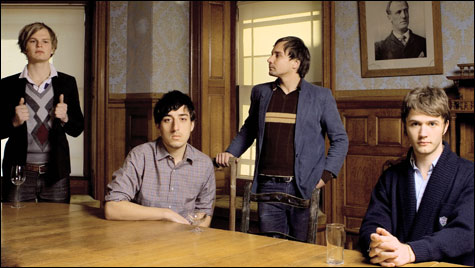
OLD-FASHIONED SONGWRITING: It’s the attention paid to the pop basics of melody and harmony that make Yellow House so rewarding.
|
Conventional wisdom has it that the democratization of music brought on by the digital age has decreased our collective musical attention span. We have so much free access to music that if a song doesn’t grab us straight away, we can call up another with the click of a mouse. On the surface, that makes a survival-of-the-fittest (or fastest) sense. But the recent success of a number of indie-rock artists suggests that people are still putting some effort into listening. Some of the most celebrated indie albums of the past couple of years — Joanna Newsom’s Ys (Drag City) and Animal Collective’s Feels (Fat Cat), for two — are growers, albums that seep under the skin during repeated play. Anyone who tells you he or she fell in love with either at first listen is probably lying. But enough people delved into those albums that when Newsom and AC last came through town, they had no problem packing big venues — the Somerville Theatre and Avalon, respectively.
Now you can add AC’s Brooklyn brethren Grizzly Bear to the list of indie artists who defy shrinking attention spans. Their sophomore effort, Yellow House (Warp), is most certainly a grower. Like Ys and Feels, it favors long, complex songs — trad-pop verse/chorus/verse structures be damned — and unconventional instrumentation. Its catchiest hooks reveal themselves gradually as the songs twist and turn through odd sonic landscapes of wind instruments, strings, and electronics.
“I don’t really think it’s an immediate album,” says founder Ed Droste when I reach him at his Williamsburg home. “I was worried that people were going to hear a sample of a song on a blog and then write it off if they weren’t instantly falling in love with it.” In fact, the opposite happened: Yellow House has garnered near-universal praise from bloggers, Webzines, and old media outlets alike, and Droste and his mates — Chris Bear, Dan Rossen, and Chris Taylor, all of whom play multiple instruments and sing — have just set out on a big headlining tour, the second gig of which is a sold-out show at Boston’s Museum of Fine Arts this Friday.
Droste started Grizzly Bear in 2004 soon after graduating from NYU’s Gallatin undergrad program. He was working at a documentary film company where he learned how to edit sound using Pro Tools. “I started tinkering around, and that was the basis and the beginning of [GB’s first album] Horn of Plenty: me learning how to use this recording machine and suddenly picking up the guitar that I had in high school and hadn’t played in like five years. I was going through a break-up and had a weird urge to create music.”
Horn of Plenty, which came out on Kanine Records in late ’04, amounted to a solo album that Droste made in his bedroom with Bear helping out toward the end of the project. Rossen and Taylor joined shortly thereafter, and Grizzly Bear became a proper band. Some publications credit Droste as the leader and primary songwriter, but he stresses that Yellow House was “really collaborative on an extreme level.” Rossen shares songwriting duties, and Taylor, who produced and engineered the album, is responsible for many of its sonic flourishes and textures.
So was it hard for Droste to relinquish complete control of a band that began as a solo project?
“I was actually really excited about it. I liked being challenged and just bouncing ideas off each other. I think the end product is much better when we were able to all sort of . . . not combat each other, but butt heads at times and come to better conclusions together. It’s really communal creativity going on, and everyone’s really involved. Even in the live show, everyone sings, so there’s not really like super front-person vibe. And I’m glad because I didn’t really want to be that.”
Although the album’s press release will have you believe it was recorded in Droste’s mom’s living room “in a yellow house just off Cape Cod,” the yellow house is actually in Watertown. Droste’s family moved into it the day he was born in 1978, and he lived there until he was 18, with the exception of one year — “not a very good year” — when the family moved to Colorado temporarily. That year and Droste’s relationship with his father are the subject of Yellow House’s melancholy closer, “Colorado”: “When I clung to you there was nothing to hold on tight with/You left me adrift/Colorado, what now?”